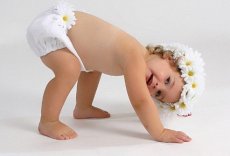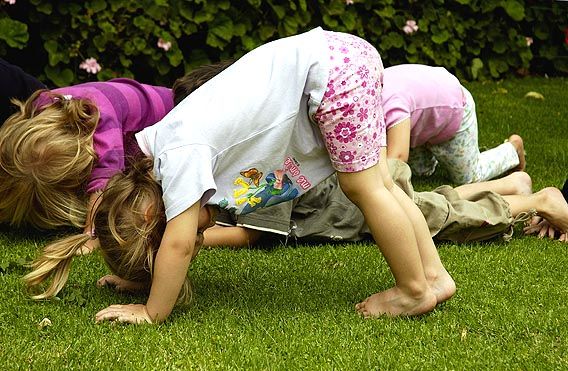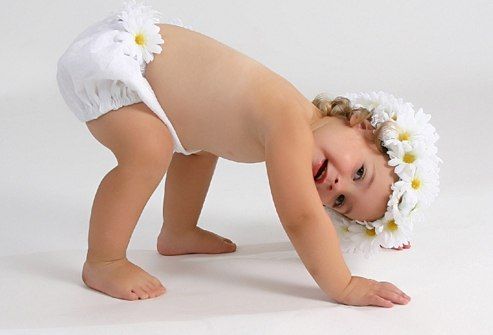Medical expert of the article
New publications
Morning gymnastics for children of 2-3 years old
Last reviewed: 04.07.2025

All iLive content is medically reviewed or fact checked to ensure as much factual accuracy as possible.
We have strict sourcing guidelines and only link to reputable media sites, academic research institutions and, whenever possible, medically peer reviewed studies. Note that the numbers in parentheses ([1], [2], etc.) are clickable links to these studies.
If you feel that any of our content is inaccurate, out-of-date, or otherwise questionable, please select it and press Ctrl + Enter.

Morning exercises for children of preschool age have a very good effect on their height and weight, as well as on the formation of posture. Only it must be done correctly. The main thing is that gymnastics for children does not exceed 10-15 minutes, and the exercises are simple and varied, so that children do not get bored.

Why do children need morning exercises?
Small children cannot yet move in a coordinated manner. Their motor skills are still being formed. Therefore, adults should give the child exercises that will help strengthen the body and help develop coordination of movements. How do exercises differ from regular physical work?
- Gymnastics develops the muscle groups that you have planned. You can focus on developing a specific muscle group.
- Gymnastics allows you to adjust the loads according to the child's health and his interests in exercises. For example, the same muscle groups can be trained using exercises with poems, gymnastics without the use of objects and with their use. Therefore, you can choose the appropriate group of exercises.
Before you start hardening your child and accustoming him to morning exercises, you need to take into account that morning exercises are contraindicated for some children. These are children who have a weak cardiovascular system, problems with the musculoskeletal system, and general weakness, the causes of which have not been established.
If a child does morning exercises, he:
- Activates all body systems, including water-salt metabolism, energy metabolism, filling the blood with oxygen and nutrients
- The child strengthens all muscles, which contributes to his better development and growth.
- The child develops correct posture, and this is a very important step, since the child’s skeleton is formed until the age of 13.
- The fact that the child performs rhythmic exercises gives him the ability to properly adjust his breathing. It is for the best functioning of the respiratory system that morning exercises for a child of 2-3 years old should be carried out in the fresh air or in a well-ventilated room.
It is very important for children aged 2-3 to maintain an average pace during morning exercises. The pace of the exercises should increase and slow down gradually - you cannot stop the exercises immediately. You need to finish the exercises like this: first - running, then - fast walking, then - slow walking and finally you can gradually stop. Therefore, you should not do breathing exercises after running and fast walking - this will put a strain on the heart and blood vessels, which is undesirable for a small child.
Exercise groups for a child 2-3 years old
Children aged 2-3 years should wear comfortable and loose clothing and comfortable, high-quality, breathable shoes during morning exercises. This will allow the clothes to absorb sweat and at the same time the skin can breathe. Simple but interesting exercises for children aged 2-3 years should be divided into at least three groups. These groups are designed to strengthen different muscles and parts of the child's spine. The exercises should be simple, otherwise the child will not be able to do them and will quickly lose interest in morning exercises.
First group of exercises
To strengthen the shoulder girdle and arm muscles, straighten the upper spine, form correct posture and correct breathing.
- We walk in the direction we like, then we walk in place, then we turn around. The starting position is to spread your legs shoulder-width apart, lower your arms along your body. Arms up, then lower them, and do this 4 times.
- Starting position: place your feet wider than your shoulders, lower your arms down. In this position, bend forward so that your toes touch the floor – then straighten up. Do this 4 times.
- The starting position is whatever is comfortable for the child. So, you can jump. There can be 6-8 jumps, this really lifts the child's mood. Then you need to walk around so that the breathing calms down. This is how we complete the first group of exercises for a child aged 2-3 years.
The second group of exercises
It is designed for flexibility of the skeletal system, in particular, the spinal column, strengthening of the back muscles. The starting position is sitting with crossed legs (or straight). When the child performs the exercises, the knees should not bend.
- Walk in the direction that the child likes best, then walk in place, then turn towards the adult.
- Starting position: legs slightly apart, arms along the body. You need to stretch your arms up, stretch well, then lower your arms. This exercise should be repeated 4 times.
- Place your legs wider than your shoulders and hang your arms down along your body. In this position, lean forward and tap your knees with your palms. This is very amusing for kids. The exercise can be repeated up to 5 times.
- The legs are not very wide apart, and the arms are down, along the body. We squat down - hands on the knees. And straighten up. The exercise can be repeated up to 5 times. To calm your breathing, you need to walk in place for a bit.
The third group of exercises

It is designed to strengthen the abdominal muscles, develop ankle muscles, and form flexibility in the arch of the foot.
- The starting position for these exercises is standing and keeping your back straight, and during squats you should keep your heels on the floor.
- You need to walk in different directions, then switch to light jogging, do a couple of circles, and then switch to walking in place. Then you can turn to face the adult, approach the chair.
- Starting position: legs apart, arms along the body, the child stands next to the chair. Lean towards the chair, lean on it with your hands, swing back and forth. You can say "tick-tock" like a clock. The exercise can be repeated 4-5 times.
- Starting position: sit on a chair, put your legs parallel to each other, put your hands on your knees. Lean forward - bend your arms at the elbows - turn your head left and right, as if looking out the window. Then straighten up. The exercise can be repeated 4 times.
- Starting position – any pose. Then – jumping in place, which is repeated 6-8 times. The exercise can be alternated with walking in place.
Morning exercises for children aged 2-3 years are a very simple but very useful way to strengthen the child’s body, lift his mood and teach him to be organized.

